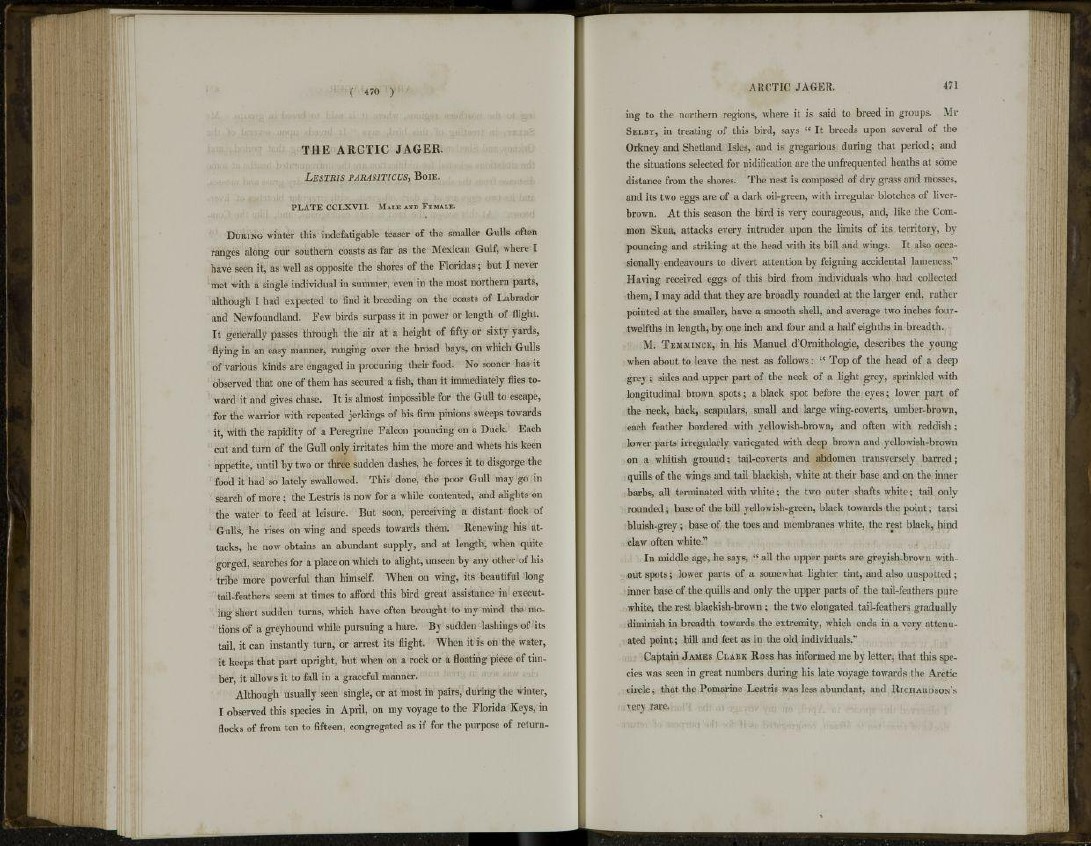
THE ARCTIC JAGER.
LESTRIS PARASITICUS, BOIE.
PLATE CCLXVII. MALE AND FEMALE.
DURING winter this indefatigable teaser of the smaller Gulls often
ranges along our southern coasts as far as the Mexican Gulf, where I
have seen it, as well as opposite the shores of the Floridas; but I never
met with a single individual in summer, even in the most northern parts,
although I had expected to find it breeding on the coasts of Labrador
and Newfoundland. Few birds surpass it in power or length of flight.
It generally passes through the air at a height of fifty or sixty yards,
flying in an easy manner, ranging over the broad bays, on which Gulls
of various kinds are engaged in procuring their food. No sooner has it
observed that one of them has secured a fish, than it immediately flies toward
it and gives chase. It is almost impossible for the Gull to escape,
for the warrior with repeated jerkings of his firm pinions sweeps towards
it, with the rapidity of a Peregrine Falcon pouncing on a Duck. Each
cut and turn of the Gull only irritates him the more and whets his keen
appetite, until by two or three sudden dashes, he forces it to disgorge the
food it had so lately swallowed. This done, the poor Gull may go in
search of more; the Lestris is now for a while contented, and alights on
the water to feed at leisure. But soon, perceiving a distant flock of
Gulls, he rises on wing and speeds towards them. Renewing his attacks,
he now obtains an abundant supply, and at length, when quite
gorged, searches for a place on which to alight, unseen by any other of his
tribe more powerful than himself. When on wing, its beautiful long
tail-feathers seem at times to afford this bird great assistance in executing
short sudden turns, which have often brought to my mind the motions
of a greyhound while pursuing a hare. By sudden lashings of its
tail, it can instantly turn, or arrest its flight. When it is on the water,
it keeps that part upright, but when on a rock or a floating piece of timber,
it allows it to fall in a graceful manner.
Although usually seen single, or at most in pairs, during the winter,
I observed this species in April, on my voyage to the Florida Keys, in
flocks of from ten to fifteen, congregated as if for the purpose of return-
ARCTIC JAGER. 471
ing to the northern regions, where it is said to breed in groups. Mr
SELBY, in treating of this bird, says " It breeds upon several of the
Orkney and Shetland Isles, and is gregarious during that period; and
the situations selected for nidification are the unfrequented heaths at some
distance from the shores. The nest is composed of dry grass and mosses,
and its two eggs are of a dark oil-green, with irregular blotches of liverbrown.
At this season the bird is very courageous, and, like the Common
Skua, attacks every intruder upon the limits of its territory, by
pouncing and striking at the head with its bill and wings. It also occasionally
endeavours to divert attention by feigning accidental lameness.11
Having received eggs of this bird from individuals who had collected
them, I may add that they are broadly rounded at the larger end, rather
pointed at the smaller, have a smooth shell, and average two inches fourtwelfths
in length, by one inch and four and a half eighths in breadth.
M. TEMMINCK, in his Manuel d'Ornithologie, describes the young
when about to leave the nest as follows: " Top of the head of a deep
grey; sides and upper part of the neck of a light grey, sprinkled with
longitudinal brown spots; a black spot before the eyes; lower part of
the neck, back, scapulars, small and large wing-coverts, umber-brown,
each feather bordered with yellowish-brown, and often with reddish ;
lower parts irregularly variegated with deep brown and yellowish-brown
on a whitish ground; tail-coverts and abdomen transversely barred ;
quills of the wings and tail blackish, white at their base and on the inner
barbs, all terminated with white; the two outer shafts white; tail only
rounded; base of the bill yellowish-green, black towards the point; tarsi
bluish-grey ; base of the toes and membranes white, the rest black, hind
claw often white.11
In middle age, he says, " all the upper parts are greyish-brown without
spots; lower parts of a somewhat lighter tint, and also unspotted ;
inner base of the quills and only the upper parts of the tail-feathers pure
white, the rest blackish-brown ; the two elongated tail-feathers gradually
diminish in breadth towards the extremity, which ends in a very attenuated
point; bill and feet as in the old individuals.11
Captain J A M E S CLARK Ross has informed me by letter^ that this species
was seen in great numbers during his late voyage towards the Arctic
circle; that the Pomarine Lestris was less abundant, and RICHARDSON'S
very rare.